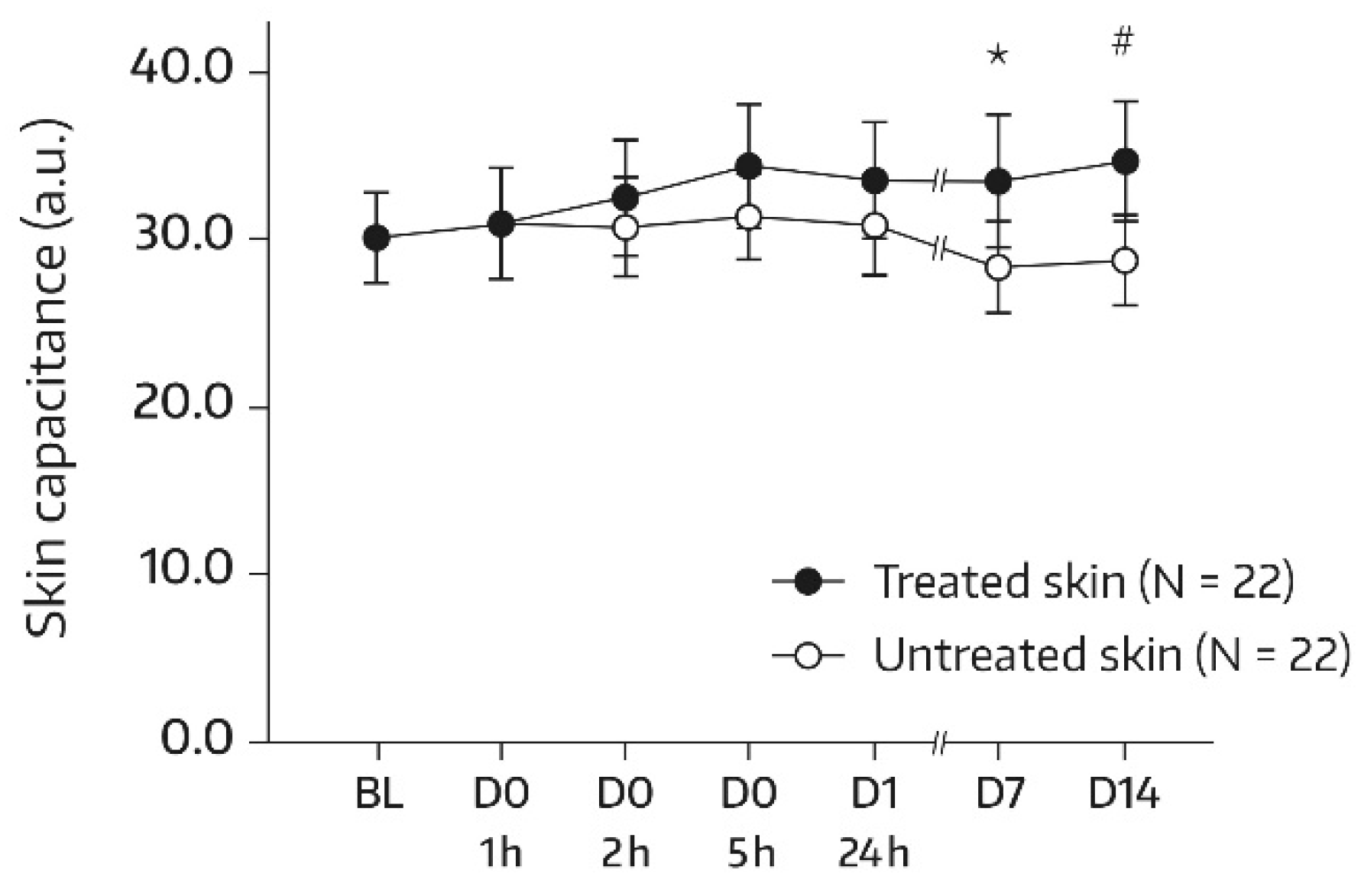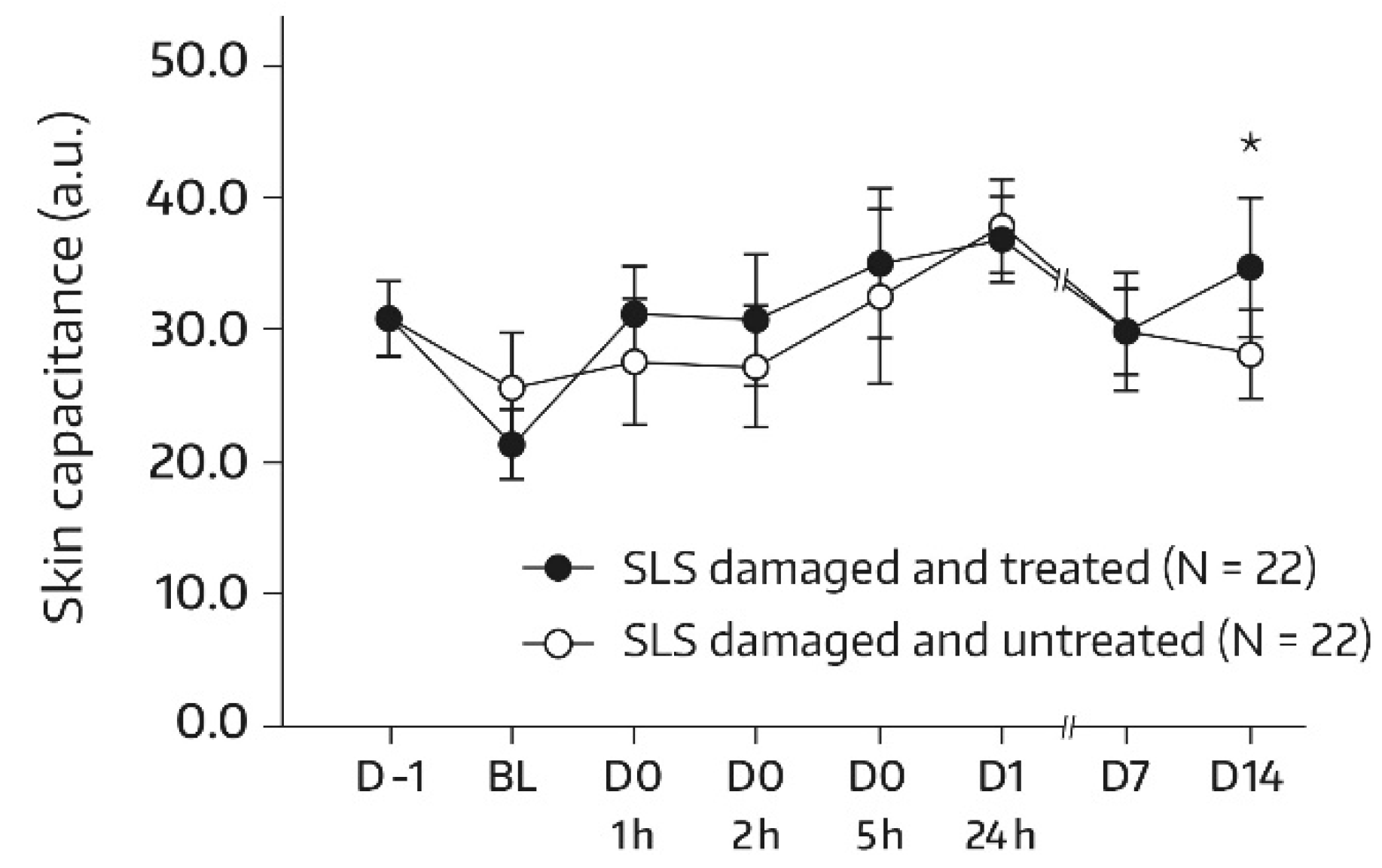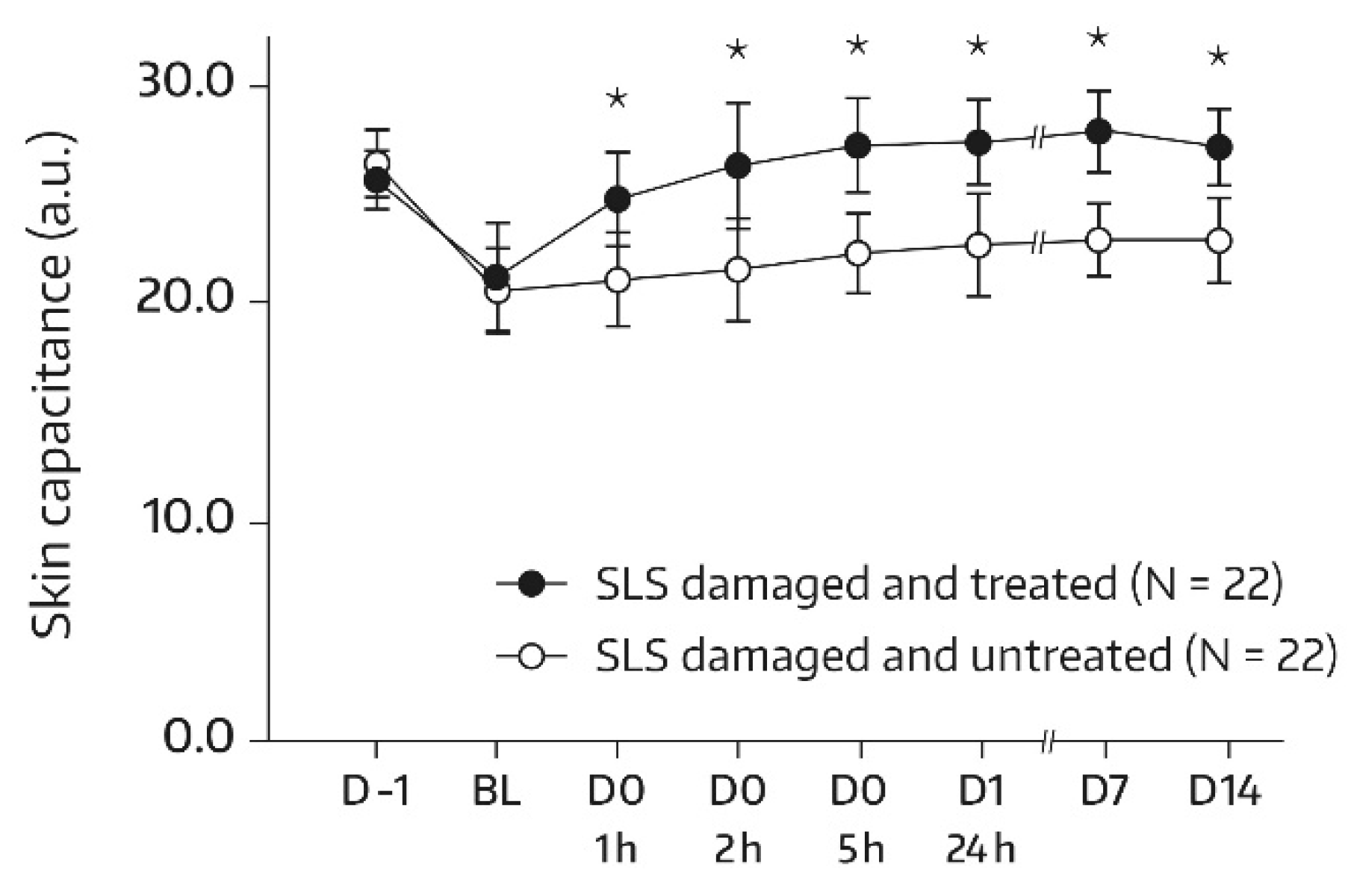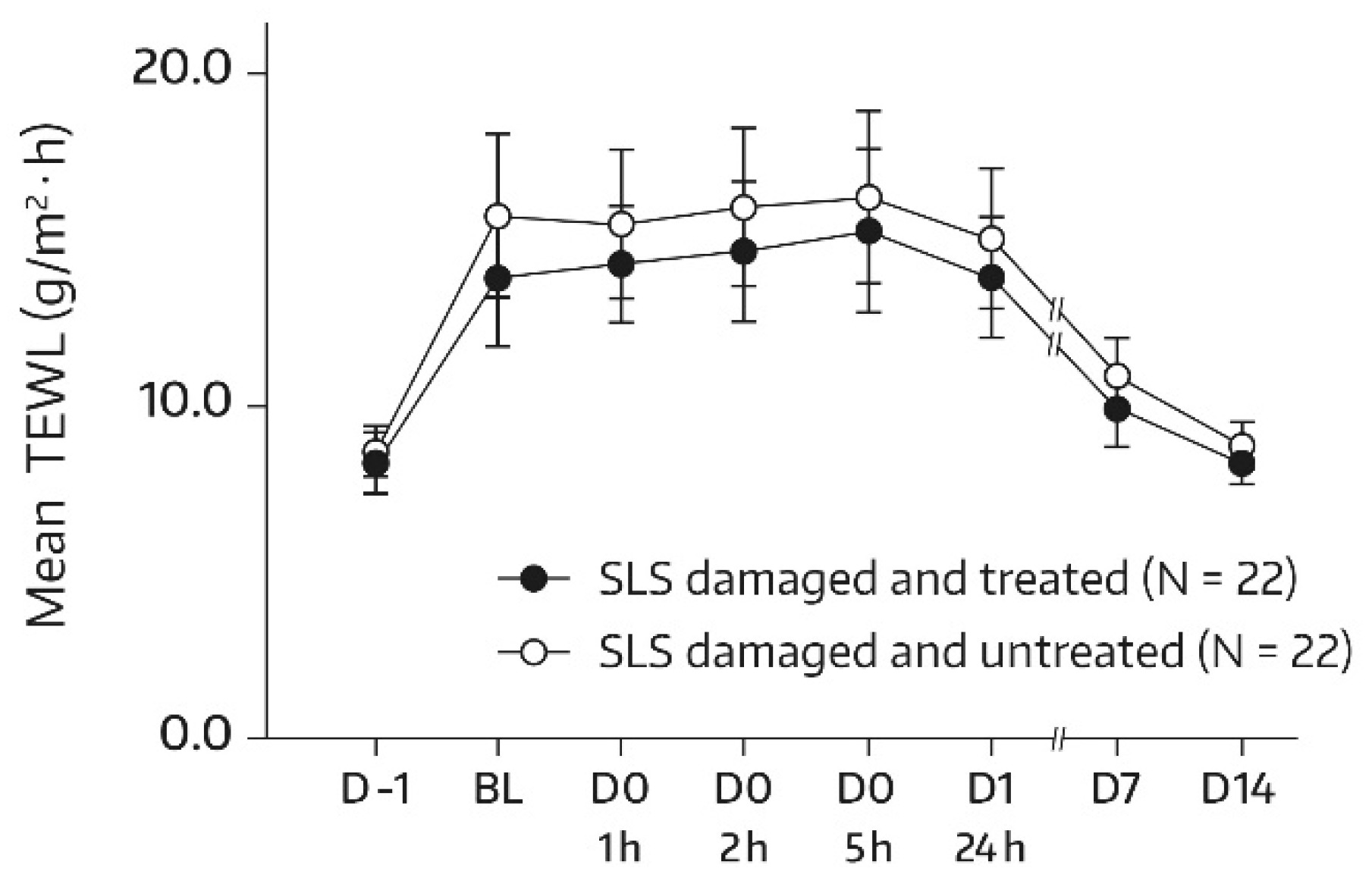1. Introduction
Skin cleansers are available worldwide in different forms, such as bars, creams, liquids, or gels, to be applied together with water [
1]. The most frequently used cleansing products are soap (ionic)-based [
1]. However, soap-based products may cause damage to the stratum corneum (SC) and extensive dryness [
2,
3,
4]. This is of particular relevance for dry skin sufferers because xerotic skin is associated with an already existing reduced skin hydration and damaged SC. The latter leads to deficient barrier function with increased transepidermal water loss (TEWL), thereby fostering the ‘dry skin cycle’ [
5,
6]. Other features of dry skin include an altered lipid organization/composition and content, as well as impaired corneocyte differentiation [
7]. Gentle skin cleansing without further compromising the skin’s natural protective barrier and moisture level is therefore an important element of body/face wash products to be used on a regular basis by dry skin sufferers.
Against this background, two new dexpanthenol-containing wash gels for daily external use (face wash gel (Bepanthen
® Derma Gentle Face Cleanser) and body wash gel (Bepanthen
® Derma Gentle Body Cleanser)) were developed for dry skin conditions; dry skin (xerosis) represents a common dermatological disorder [
8]. Apart from the amount of non-soap (non-ionic)-based surfactants ensuring cleansing and foaming, the key ingredients are the same in the two wash gels and comprise dexpanthenol, argan oil, glycerin, and niacinamide. The face wash gel contains a lower proportion of surfactants (e.g., disodium cocoyl glutamate, lauryl glucoside) than the body wash gel. Other ingredients in common for the two wash gels include 1,2-hexanediol, lysine, guar hydroxypropyltrimonium chloride, xanthan gum, and citric acid. The composition was largely motivated by the objective to provide simultaneously gentle effective cleansing at a skin-friendly pH (5.5) and skin-moisturizing effects with the same product, thereby complying with modern cleanser technology [
9] and appropriately addressing the needs of dry skin sufferers. Maintenance of barrier function and good tolerability should equally be ensured. These objectives were to be met by the addition of ingredients that are typically used in emollients, without compromising the cleansing efficacy of the wash gels. Specifically, the new wash gels contain a non-physiological lipid (argan oil), a humectant (glycerin), an antipruritic/soothing agent (niacinamide), and a multifunctional ingredient, including the enhancement of epidermal differentiation (dexpanthenol) [
10]. These ingredients belong to the key components of an ideal emollient for dry skin management [
7]. The benefits of using a body/face wash enriched with emollient ingredients were demonstrated previously; less unfavorable effects on skin barrier integrity and reduced loss of SC hydration were observed compared with regular wash products, while still functioning as cleansers [
3,
9,
11,
12].
According to cosmetic regulations, claims for cosmetic products have to be supported by adequate and verifiable evidence [
13]. Taking these recommendations into account, we explored the biophysical and cosmetic properties of each of the new wash gels in individual randomized 2-week studies (with similar designs) involving healthy adult subjects with dry skin. Instrumental measurements quantified the effects of the wash gels on SC hydration and TEWL (with and without a previous sodium lauryl sulfate (SLS) challenge) after single and repeated usage. The cutaneous tolerability and the subjective cosmetic performance of the wash gels were assessed as well.
2. Methods
The two studies were conducted in healthy adult subjects with a dry skin condition under the supervision of a dermatologist at Eurofins Evic Product Testing Romania SRL, Bucharest, Romania, between November 2019 and December 2019. The trials were performed according to the Declaration of Helsinki with all its amendments. Subjects gave written informed consent to participate after being informed about the study procedures. The new wash gels used in the trials were provided by Bayer Consumer Care AG, Basel, Switzerland. For both trials, ethics approval was obtained from an independent institutional ethics committee.
Given the exploratory nature of the two studies, no primary or secondary variables were defined. For the same reason, no formal sample size calculation was performed. Based on historical data from similar studies, it was expected that scientifically reliable results could be gathered with the selected sample size [
10,
14].
2.1. Study 1: Face Wash Gel
2.1.1. Study Design
Study 1 was a randomized, open-label, intraindividual comparison study in healthy adults with dry skin. Study participants were sequentially allocated into two groups. Group 1 had test skin areas on the face (cheeks) and forearm, and group 2 had test skin areas on the face only. Both groups visited the study center on day 0 (baseline) and study days 1, 2, 7, and 14. In the group 1 subjects, skin barrier dysfunction was experimentally induced at one skin area on each volar forearm via the application of 0.8% SLS (1 mL) under a semiocclusive patch (Tegaderm
®, 3M Health Care, Neuss, Germany) for 24 h, as reported previously [
10]. Subjects undergoing the SLS challenge had an additional study visit on day -1 to have the SLS and patch applied.
Study participants came to the study site without having administered the face wash gel on that day.
All subjects in both groups had test areas F1 and F2 on their upper cheeks. Areas on the face were randomly allocated to the right or left cheek. Subjects of group 1 had additional test areas marked on their volar forearms (A1, A2, A3, A4). Each of these test areas had a size of 16 cm2. Skin areas A1 and A3 were always on the same arm, while A2 and A4 were located on the contralateral arm. On areas A3 and A4, the SLS challenge was performed. The face wash gel was applied on skin areas F1 and F2, as well as on areas of one volar forearm (A1, A3). The areas of the contralateral arm (A2, A4) served as controls for A1 and A3, respectively, and were not treated with the face wash gel. The locations of A1 and A3 on the same forearm were chosen via randomization. Likewise, the allocation of forearms (left or right) to treatment with the face wash gel was carried out in a randomized fashion. Subjects in group 2 had only the face as the investigational site (skin areas F1 and F2).
During the study, the face wash gel was applied to the assigned test areas (F1, F2, A1, and A3 for group 1; F1 and F2 for group 2). For the face, subjects were instructed to wet the face, gently massage the face wash gel onto the entire face, and then rinse and gently wipe dry. For the forearms, they were instructed to wet the skin, make a foam in the palms of their hands and apply the product to the assigned forearm, then rinse and gently wipe dry. The first application was made with the support of a technician at the investigational site on day 0 after baseline assessments. No face wash gel was applied within the first 24 h after the initial application. Thereafter, the administration of the study product was performed by the subjects themselves at home on a twice-daily schedule (morning and evening) until day 14. In the group 1 subjects, SLS patches were removed 30 min before the first product administration (day 0, baseline). At that time, the SLS challenge was finalized. Compliance was assured by weighing each plastic bottle (200 mL) with face wash gel before and after the treatment period.
2.1.2. Subjects and Assessments
Generally, the inclusion and exclusion criteria were in line with a previous study that was recently conducted at the same study center using topical dexpanthenol-containing cosmetic body emollients [
10].
Healthy male and female subjects, aged 18 to 70 years and having skin types II–IV on the Fitzpatrick scale [
15] were eligible for study enrolment. Subjects were required to have very dry and flaky skin on the face, as judged clinically by the dermatologist involved in the study. For inclusion, females had to be nonpregnant and nonbreastfeeding. Female subjects of childbearing age were requested to use a reliable method of contraception during the study.
Subjects were excluded from study participation if they had: any skin condition at the target areas that would interfere with the interpretation of the study results (e.g., pigmentation disorders, many freckles or naevi, history of atopic skin, presence of acne or rosacea, excessive pilosity, irritated skin, scars); a condition requiring the use of drugs interfering with study assessments within 6 months (systemic retinoids), 3 months (other systemic antiacne medication), 2 months (topical retinoids), 1 month (other topical antiacne medication), or 2 weeks (antiacne cosmetic products, antibiotics, topical or systemic use of anti-inflammatory drugs or antihistamines) prior to or during the study; initiation/change of estrogen-progesterone contraception or hormonal treatment within 3 months prior to or during the trial; allergies to any ingredient of the study product; history of adverse reactions to cosmetic products; vaccination within 2 weeks before or during the study; desensitization treatment within 6 months prior to start of the study.
Study participants were not permitted to have had any noninvasive (e.g., skin cleansing, scrub) or invasive (e.g., peeling, laser treatment) cosmetic interventions on the face and forearms within 1 month and 2 months, respectively, before and during the study. Likewise, intensive exposure of face and forearms to ultraviolet light was not allowed within 1 month prior to and during the trial. Subjects were also not allowed to use topical preparations other than the study product on the face and forearms throughout the study course. On visit days at the study site, subjects had to come to the trial center without having applied any product to the target areas. Moreover, subjects were not permitted to use detergents on the face and forearms since the previous evening; the consumption of hot beverages (e.g., coffee or tea) within 2 h before instrumental assessments was not allowed either.
The SC moisturization status was measured using a corneometer (Corneometer
® CM825, Courage & Khazaka, Cologne, Germany). This corneometer determines the electrical capacitance of the skin surface, which is a function of the SC water content [
16]. Measurements took place on the face area F2 (groups 1 and 2) and on each of the forearm skin areas A1 and A2 (group 1) at baseline and at 1, 2, 5, and 24 h (day 1) after the first and single application of the face wash gel. Additional assessments took place on study days 7 and 14. For all subjects in group 1, SC hydration was also determined in skin areas A3 and A4 of the forearms. For these test areas, the assessment times were identical to those of areas F2, A1, and A2, except for an additional measurement on day -1 prior to the SLS application. Three measurements were performed in the individual test areas per assessment time. An increase in skin capacitance/corneometry values corresponds to improved skin hydration [
17].
TEWL (MPA Tewameter
® TM300, Courage & Khazaka, Cologne, Germany) measurements took place on the face area F1 (groups 1 and 2) and on each of the forearm skin areas A1 and A2 (group 1) according to the same schedule as the SC hydration measurements. For subjects in group 1, TEWL was also quantified in skin areas A3 and A4 on day -1 when the SLS application took place; subsequent TEWL assessment times in these test areas were identical to those of areas F1, A1, and A2. There was one measurement per allocated skin area and assessment time. By means of TEWL measurements, the SC barrier function can be reliably quantified in an easy and noninvasive fashion; an increase in TEWL reflects worsening barrier function [
18,
19].
Instrumental measurements (i.e., corneometry, TEWL) have been widely used to study the effects of cleansing products on the SC [
9] and were conducted as reported previously [
10]. In brief, prior to instrumental measurements, subjects remained in a climatized room (20 ± 2 °C, 45 ± 15% relative humidity) for 15–20 min. During the measurements, the ventilation system of the air conditioner was stopped to limit the movement of air. The skin target areas treated with the face wash gel were wiped dry with a paper towel before measurements and after the product was rinsed off. If various instrumental measurements were conducted in the same skin area at a given time point, different skin sites were to be used.
To determine the cosmetic performance of the face wash gel, the subjects had to complete a validated self-assessment questionnaire when they visited the study center on day 14. The questionnaire was designed based on the guidance provided by the American Society for Testing and Materials [
20]. For the assessment of cosmetic performance, the subjects had to rate 45 statements on a numerical scale ranging from 0 to 6 (0 = strongly disagree, 1 = moderately disagree, 2 = slightly disagree, 3 = neither agree nor disagree, 4 = slightly agree, 5 = moderately agree, 6 = strongly agree). Cutaneous tolerability and adverse events (AEs) were monitored throughout the study period.
2.1.3. Statistical Evaluation
The statistical evaluations were conducted using SPSS (version 22, IBM, Armonk, NY, USA). For the corneometry and TEWL determinations, a global repeated measures analysis of variance (ANOVA) was performed to identify any differences between the mean values assessed at baseline and measurements thereafter. Depending on the data distribution, the paired t-test or Wilcoxon signed-rank test was applied to test whether there was any significant mean change in instrumental measurements between the baseline and each postbaseline determination. A paired t-test was used to detect differences in the corneometry and TEWL values between the skin areas that were treated and nontreated (control) with face wash gel. For all statistical analyses, the level of significance was set at 0.05. For the analysis of data from the corneometry and TEWL measurements (change from baseline), a Bonferroni correction was applied to control for multiple comparisons over time. In these cases, the p-value for significance was set at a lower level. AEs and results from the questionnaire were analyzed in a descriptive way. As prospectively defined, results from the instrumental measurements in skin areas F1 and F2 were pooled for groups 1 and 2.
2.2. Study 2: Body Wash Gel
Study 2 was a randomized, open-label, intraindividual comparison study in healthy adults with dry skin. Study participants were sequentially allocated into two study groups. Group 1 had the test areas A1, A2, A3, and A4 marked on their volar forearms; group 2 had the test areas A1 and A2 only. Each of the test areas had a size of 16 cm2. Skin areas A1 and A3 were always on the same arm, while A2 and A4 were located on the contralateral arm. In areas A3 and A4, an SLS challenge was performed as described for study 1. The body wash gel was applied to skin areas A1 and A3; the areas of the contralateral arm (A2, A4) served as controls and remained untreated. The locations of A1 and A3 on the same forearm and the forearm (left or right) to be treated with the body wash gel were chosen via randomization. The body wash gel was applied once daily on the assigned test areas (A1 and A3 for group 1; A1 for group 2). Subjects were instructed to wet the skin, make a foam in the palms of their hands, and apply the study product to the assigned forearm, then rinse and gently wipe dry. By using the same procedure, the rest of the body (except the forearm with control areas A2 and A4) was treated once daily with the body wash gel. The first application was made with the support of a technician at the investigational site on day 0 after baseline assessments. No body wash gel was applied within the first 24 h after the first application. Thereafter, the administration of the study product was performed by the subjects themselves at home using a once-daily schedule (evening) until day 14. Compliance was assured by weighing each plastic bottle (200 mL) with body wash gel before and after the treatment period.
The visit schedule, inclusion/exclusion criteria, assessments (including time points), and statistics related to study 2 were identical to study 1, with the exception that subjects were required to have very dry, flaky skin on the body (instead of the face), as judged clinically by the dermatologist involved in the study. In addition, in study 2, the results from the instrumental measurements in skin areas A1 and A2 were pooled for groups 1 and 2, as prospectively defined in the study protocol.
4. Discussion
Two novel wash gels for daily external use (face wash gel and body wash gel) were developed to address the needs of dry skin conditions. Both wash gels are enriched with emollient ingredients (e.g., dexpanthenol) and only differ in the content of non-ionic-based surfactants. The basic objective was to formulate wash products that simultaneously deliver gentle effective cleansing and skin-hydrating effects, without impairment of the SC barrier function. In this context, two studies explored for the first time the effects of the new wash gels on SC hydration and TEWL (with and without SLS challenge), as well as their cutaneous tolerability and cosmetic performance after single and continued applications in subjects with dry skin.
If compared with contralateral skin areas and/or baseline assessments, the study results can be summarized as follows: (1) following a single application of the face wash gel to dry skin of the face, skin capacitance was significantly increased for up to 24 h, indicating long-lasting facial skin hydration; (2) after twice-daily applications of the face wash gel to dry facial skin, as well as to dry SLS-undamaged and SLS-damaged skin of the forearm for approximately 2 weeks, skin capacitance was significantly increased at the final or both weekly assessments, suggesting long-term hydration; (3) following single and repeated once-daily applications of the body wash gel to dry skin of the forearm for approximately 2 weeks, skin capacitance was numerically increased compared with the control area at all assessments and reached statistical significance at selected time points (e.g., day 7); (4) following single and repeated once-daily applications of the body wash gel to dry SLS-damaged skin of the forearm for approximately 2 weeks, skin capacitance was significantly increased at all time points later than 1 h postbaseline, suggesting long-lasting and long-term hydration; (5) following single and prolonged daily applications of both wash gels to dry SLS-undamaged and SLS-damaged skin of the forearm, and to dry skin of the face (face wash gel only) for approximately 2 weeks, no effects on the TEWL were observed, suggesting that both wash products exerted no adverse effects on skin barrier function and did not interfere with spontaneous barrier healing of experimentally damaged skin; (6) both wash gels were well tolerated and the cosmetic performances were appreciated by the overwhelming majority of subjects.
It can be inferred that both wash gels were effective cleansers without irritating the skin. At the same time, both wash gels acted as skin moisturizers without further compromising the skin’s natural protective skin barrier. This is an advantage compared to regular, soap-based products, which may cause SC damage and pronounced dryness [
2,
3,
4]. The features of the new wash gels are particularly favorable for dry skin sufferers because xerotic skin already displays reduced skin hydration and damaged SC barrier function [
6,
7]. Hydration of the skin not only improves dryness but also reduces pruritus and helps to restore disturbed barrier function [
21]. Therefore, the two new wash gels can be considered a significant contribution to a modern personal care regimen in dry skin conditions. The here-presented approach of adding ingredients, typically used in emollients, to body/face wash products can be claimed successful as it resulted in body and face wash gels showing moisturizing properties, which was thought to be impossible for a long time [
9].
Our results are in accordance with previous trials that demonstrated beneficial effects (i.e., reduced loss of SC hydration and/or less adverse effects on skin barrier integrity) when studying body/face washes enriched with emollient ingredients versus regular cleansers [
2,
3,
11,
12]. In these studies, the cleansing washes contained a single emollient or a combination thereof, such as petrolatum, glycerin, fatty acids, and/or soybean oil. For the new wash gels tested in our two studies, mild non-ionic-based surfactants were combined with ingredients that belong to the key components of an ideal emollient: a non-physiological lipid (argan oil), a humectant (glycerin), an antipruritic/soothing agent (niacinamide), and a multifunctional ingredient (dexpanthenol) [
7].
Considering recent evidence, it is thought that the skin-moisturizing effect and good cosmetic performance mediated by the two wash gels in our studies were triggered by the emollient ingredients added to the formulations.
The SC of dry skin reveals an altered lipid organization/composition and reduced lipid content [
7,
22]. Niacinamide, which is present in the wash gels tested in our studies, enhances the biosynthesis of natural SC lipids in addition to its antipruritic effects [
23,
24]. In a previous study in healthy subjects, the topical use of a niacinamide-containing emollient induced a significant increase in SC cholesterol and free fatty acids [
14]. Thus, niacinamide may indirectly compensate for the reduced lipid content in the SC lipid matrix observed in dry skin conditions, thereby favorably influencing the dry skin lipid layers and SC hydration. The non-physiological lipid (argan oil) present in the new wash gels acts primarily via an occlusive effect. It creates a hydrophobic barrier on the skin’s surface, resulting in restricted evaporation (i.e., it works like a temporary dressing) [
7]. Glycerin is a physiological humectant and plays an important role in keeping the SC hydrated. It is a small molecule (MW = 200–300 Da) and reaches the deeper layers of the SC. There, it restores water content and replicates the function of natural moisturizing factors [
7,
25]. Topical dexpanthenol, another key ingredient of the new wash gels, acts as a moisturizer. This activity is considered to be related to dexpanthenol’s hygroscopic properties and its capability to promote the retention of moisture [
6]. In addition, dexpanthenol reduces the increased rigidity of the SC lipid lamellae and keratin filaments observed in dry skin via interactions with lipid segments of the extracellular lamellae and protein residues in the SC corneocytes [
6]. Dexpanthenol is also able to generate properties of hydrated skin in dehydrated conditions [
26].
In our studies, the wash gels did not interfere with spontaneous barrier healing of the experimentally damaged skin. This is considered another advantage compared to regular, soap-based products, which may have a significant disrupting effect on skin barrier function. The latter worsens with repeated washing without apparent signs of skin barrier repair [
4].
The new wash gels tested in our studies did not accelerate spontaneous barrier healing of SLS-damaged skin (i.e., there was no expedited TEWL reduction). This was expected given the limited contact time of the study products with the skin.
Both wash gels were well tolerated in our trials. No cases of contact dermatitis were observed, as reported for other liquid body washes upon prolonged skin contact [
27]. In fact, in the SLS-damaged skin area undergoing single and repeated daily usage of the body/face washes, fewer AEs with shorter durations were recorded than in the untreated SLS-damaged skin area. This may have been triggered by the emollient ingredients that were added to the body/face gel formulations.
A limitation of the study investigating the face wash gel (study 1) was the absence of control areas for the facial skin areas F1 and F2. Thus, we could not account for spontaneous changes in TEWL and SC moisturization status, respectively, over the 2-week study period.












